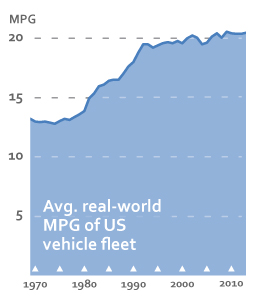Our most recent report highlighted an encouraging trend: northwesterners are using less gasoline. In all, motor fuel consumption in Washington and Oregon declined by about 4.5 percent after cresting in 2002. With population growth, that translates into a 16 percent decline in per capita fuel consumption.
 When many people hear this news, they immediately think of one thing: the Prius. Surely, the increased sales of hybrids, high-efficiency vehicles, and electric cars must be at the root of the decline in gas consumption over the past decade…right?
When many people hear this news, they immediately think of one thing: the Prius. Surely, the increased sales of hybrids, high-efficiency vehicles, and electric cars must be at the root of the decline in gas consumption over the past decade…right?
Unfortunately no. I, for one, certainly wish that sales of hybrids had yielded a significant boost in vehicle efficiency. Yet despite the rise of the hybrid car, real-world fuel efficiency has improved only a wee bit over the past two decades.
Surprised? Here’s what’s going on.
From the late 1970s through about 1991, the nation’s light-duty vehicles (cars and light trucks) grew radically more efficient. That’s when rising federal fuel economy standards quickly boosted new vehicle efficiency, and brisk vehicle sales led to rapid evolution of the US fleet. In the mid-1980s, for example, brand new cars and light trucks represented nearly one out of every ten vehicles on the road. And since cars didn’t last quite as long as they do now, older, less efficient vehicles were quickly phased out of the vehicle fleet.
But those trends largely fizzled in the 1990s and 2000s. From 1990 to 2010—two full decades—the federal government failed to raise fuel economy standards for cars. And it only boosted light truck standards modestly starting in 2005, after nearly a decade of stalled standards. (See this Wikipedia table or this federal CAFE data series for details.) Meanwhile, sales of lower-mileage SUVs, minivans, and pickups, started to outpace car sales in 2001, opening up a sizable lead that would last through the economic crash in 2008. And as sales of low-efficiency trucks outpaced sales of higher-efficiency cars, the average efficiency of new vehicles actually declined slightly from 1988 through about 2004 (see the chart on page 80 of this pdf for details), and grew only modestly after that.
But even as CAFE standards for trucks started to inch up in the mid-2000s, a massive slowdown in vehicle sales created a double whammy for efficiency gains. Slumping vehicle sales meant slower adoption of more efficient cars and trucks. It also meant that the vehicle fleet aged, reaching an all-time high of nearly 11 years, on average. And in real-world driving conditions, cars tend to become less fuel efficient as they age.
So that, in a nutshell, is why real-world efficiency gains have been so meager for the last two decades: (1) stalled out standards; (2) the rise of light trucks vs. cars; (3) falling sales just as standards were rising; and (4) an aging vehicle fleet. Those four trends led to only modest gains in fuel economy—in fact, vehicle fuel economy accounted for only about 13 percent of the reductions in per capita fuel consumption over the last decade. The bulk of the declines can be traced to lower vehicle travel per capita—a topic we’ve covered ad nauseum.
(A note: the numbers above mostly cover the national trends. Local trend data is much harder to come by, though the story above is roughly consistent with local vehicle travel and fuel consumption trends. And both the Washington State Department of Commerce and the state’s Transportation Revenue Forecast Council have used national trends as a proxy for local fuel economy trends.)
There is some promising news, though: federal fuel economy standards are set to make a serious jump over the next 13 years. So in coming years, we may see a return to rapid fuel economy gains—and, possibly, even faster declines in gasoline consumption!! And while that’s good news for consumers and the climate, it probably scares the bejeezus out of the transportation agencies hoping to pay for new roads with proceeds from the gas tax.









Jim Adcock
I suggest taking a look at the official government data on gasoline consumption in the US, and how it has — or hasn’t declined with increase CAFE fuel economy standards:
http://www.eia.gov/dnav/pet/hist/LeafHandler.ashx?n=PET&s=WGFUPUS2&f=4
Morgan
Thanks Clark for continuing to push against the belief that driving will always grow, that we’ll always need to build more roads, and that we’ll always need more fuel to support this driving.
In revenue discussions, I’ve heard many a agency staff suggest that vehicle efficiency has and will continue to drive down total fuel consumption. The subtext is usually: we need to figure out how to replace revenues in order to fund maintenance and strategic expansion.
While reading this article, I started wondering how demand for fuel efficiency by new car buyers is influenced by increases in income-inequality. I wonder how many new vehicles are purchased by the few.